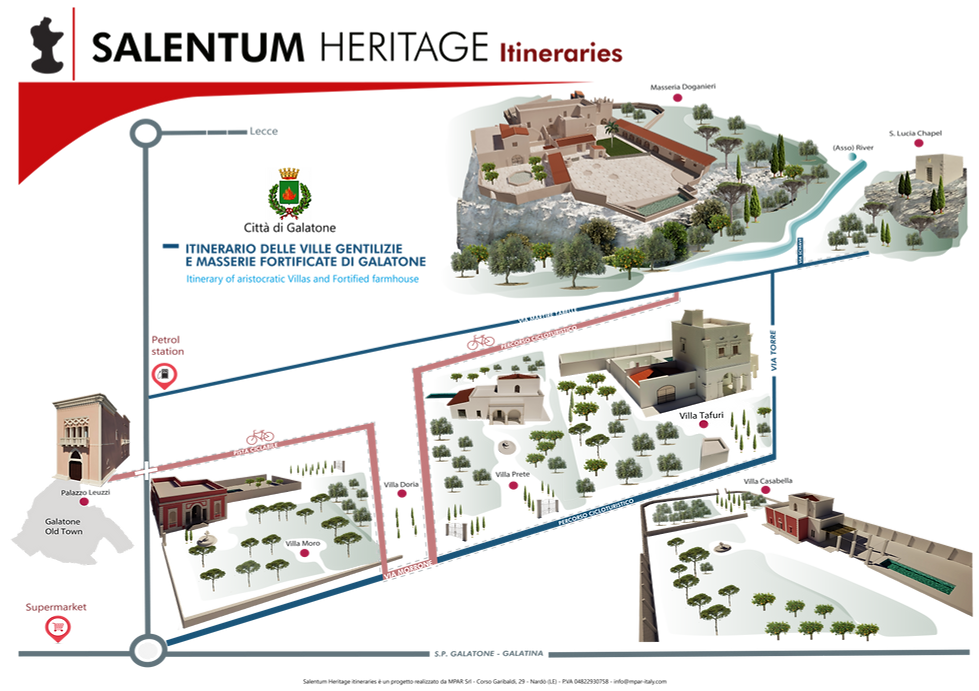

Villa Prete
In the heart of Salento, just ten minutes from the sea, this 17th-century residence welcomes guests with a scenic entrance leading to an elegant loggia supported by local stone columns. Here, among carved capitals and original decorations, stands the frescoed coat of arms of the historic Tafuri family—a testament to the villa’s noble past. Inside, spacious vaulted salons, bright bedrooms, and charming living areas blend authentic architecture with modern comfort. At the rear, a centuries-old walnut tree offers shade and coolness, creating the perfect setting for al fresco lunches and dinners. At the front, a park of over two hectares, enclosed by ancient dry-stone walls, is home to olive trees, Mediterranean fragrances, and a private pool where guests can unwind in total tranquility. With five bedrooms and five bathrooms, the villa is ideal for exclusive weekly stays, offering a unique experience of history, nature, and refinement..
GALLERY
LAYOUT


POSITION

HISTORY
Casino Prete Tafuri
In the heart of the Feudo di Tabelle, among olive groves and carefully sculpted carparo stone walls, stands the Casino Prete Tafuri, an elegant rural residence originally owned by the Tafuri barons, one of the oldest noble families of Salento. Its current name derives from its last owners, the Prete family, who acquired the property through marriage with a branch of the Tafuri family during the 19th century.
Located beside the imposing Villa Tafuri—a fortified manor with defensive functions—the casina served a complementary role: a seasonal residence and an agricultural supervisory center for the estate. This makes it a rare and well-preserved example of a noble country house typical of the Salento tradition between the 17th and 18th centuries.
Architecture
The villa was accessed through two exterior gates with wrought-iron grilles, each flanked by carved columns in local stone. Both entrances were shaded by a pergola supported by circular columns, extending all the way to the main loggia. This structure not only provided shade and coolness but also allowed climbing vines to grow freely, creating in summer a charming natural corridor of hanging grape clusters.
The main loggia, reached through the noble entrance, is defined by rectangular columns with carparo capitals, leading to a vaulted space open to the outside, designed for hospitality and leisure. The ground floor still preserves its original cocciopesto flooring, while the interiors feature a variety of barrel and star vaults, characteristic of Salento’s refined rural architecture.
On the upper floor, there is a single room with a pitched roof covered in terracotta tiles, internally finished with reed matting (cannicciato), in keeping with the building traditions of the time for light and well-ventilated spaces.
Decorations and Noble Heraldry
The noble entrance to the loggia is adorned with well-preserved polychrome floral motifs in shades of ochre, iron red, olive green, and pastel blue. Above the architrave stands an elegant fresco composition: two facing peacocks—symbols of beauty, royalty, and eternity—guard the coat of arms of the Tafuri family, set within a scrollwork frame and crowned with a noble coronet.
At the center of the coat of arms appears a stylized palm tree, a notable variant from the more common pine depicted in other branches of the family. The presence of the palm suggests that the villa belonged to a specific branch of the Tafuri, likely linked directly to the ownership of the Feudo di Tabelle.
The Tafuri were among the most influential baronial families in Salento and in the Kingdom of Naples. In addition to Galatone, they are recorded in Nardò, Galatina, Copertino, and Lecce, distinguished for their land holdings, patronage, and public offices. The Tabelle branch, in particular, exercised jurisdiction over vast agricultural areas for centuries, building both the fortified Villa Tafuri and this smaller, more intimate rural casina.
The palm-bearing coat of arms is rare and distinct from the pine or serpent motifs used by other branches. Comparable examples can be found:
• in a rural chapel between Galatone and Galatina;
• on a noble tombstone in the monumental cemetery of Nardò;
• in some urban palaces now altered or incorporated into later buildings;
• in the heraldic registers of the Kingdom of Naples, where the palm likely identifies a feudal and landowning branch, symbolizing fertility and agricultural dominion.
The Casino Prete Tafuri is an architectural and heraldic record of remarkable integrity: a small jewel nestled in the Salento countryside, bearing witness to the daily life, agricultural organization, and noble representation of the past. Beside the grander Villa Tafuri, this casino preserves the discreet yet profound memory of a noble estate lived in and cultivated—a precious heritage to be safeguarded and enhanced today.

